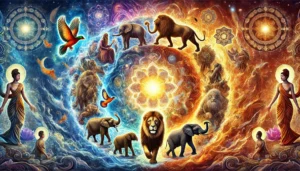
Reincarnation and animals in Hinduism
Reincarnation and Animals: The Soul’s Journey Through Samsara
Reincarnation, or punarjanma, is a foundational concept in Sanatan Dharma. It expresses the belief that the soul (atman) is eternal, transitioning through various life forms in the continuous cycle of samsara—birth, death, and rebirth. Governed by karma (the law of cause and effect), this journey is deeply intricate and emphasizes the spiritual evolution of the soul. While human reincarnation is often discussed, the role of animals in the soul’s journey through samsara unveils profound spiritual, ethical, and ecological lessons.
The Soul’s Journey: Interconnectedness of All Life
The ancient scriptures state that the soul travels through 8.4 million species before achieving human birth, which is considered rare and precious for spiritual advancement. This vast number includes plants, aquatic creatures, birds, insects, animals, and finally, humans. Each form is an opportunity for the soul to experience, learn, and grow, progressing toward moksha—liberation from the cycle of rebirth.
Rebirth into animal forms is not seen as a punishment but as a necessary phase to purify the soul. The soul carries its vasanas (impressions and tendencies from past lives) as it moves from one form to another. The animal realm represents a stage where the soul learns to harmonize with nature, develop specific traits, or burn the residual effects of negative karma.
Table of Contents
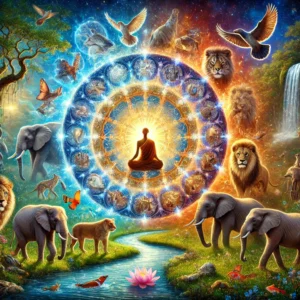
Reincarnation and animals in Hinduism
The Spiritual Significance of Animal Rebirth
In Hindu philosophy, every life form is seen as sacred, imbued with divinity. Animals are not merely passive participants in the cycle of life but play active roles in the cosmic order (rta). Reincarnation into animal forms carries significant lessons:
Experiencing Survival Instincts: Animal rebirth allows the soul to explore primal instincts, such as survival, reproduction, and protection. These experiences help purify the soul of its more materialistic tendencies.
Learning Qualities of Simplicity and Devotion: Unlike humans, animals live without the ego-driven complexities of desires and ambitions. They exhibit traits such as loyalty, unconditional love, and devotion, often teaching humans profound spiritual lessons.
Cleansing Negative Karma: Animal lives provide an opportunity for the soul to exhaust tamasic and rajasic tendencies (ignorance and excessive activity). For example, a life as a prey animal might balance out the karmic consequences of cruelty in a previous human existence.
Mythological Perspectives on Animal Reincarnation
Hindu mythology abounds with stories that emphasize the sanctity of animals and their role in spiritual evolution. These narratives not only reflect the belief in reincarnation but also underline the interconnectedness of all beings in the cosmic web.
Gajendra Moksha: In the Bhagavata Purana, Gajendra, the elephant king, symbolizes the soul trapped in the cycle of samsara. Despite his animal form, Gajendra’s unwavering devotion to Lord Vishnu earns him liberation, illustrating that divine grace transcends physical forms.
The Ramayana’s Jatayu: Jatayu, the divine vulture, sacrifices his life attempting to rescue Sita from Ravana. This tale highlights how even animals can demonstrate supreme qualities like bravery, selflessness, and devotion to dharma.
Rebirth of King Bharata: The story of King Bharata, who was reborn as a deer due to his attachment to a fawn, serves as a cautionary tale. Despite his spiritual progress, his excessive attachment led to an animal rebirth. However, his subsequent births show the possibility of reclaiming higher spiritual consciousness.
Lord Vishnu’s Dashavatara: Vishnu’s ten incarnations—several of which are in animal forms, such as Matsya (fish), Kurma (tortoise), and Varaha (boar)—highlight the divine potential within every life form. These incarnations also symbolize evolutionary stages and the soul’s journey toward perfection.
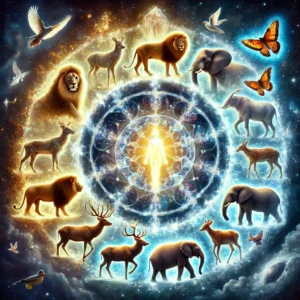
Reincarnation and animals in Hinduism
Ethical and Ecological Lessons
The belief in reincarnation through animal forms fosters a deep respect for all life. It reinforces the principle of ahimsa (non-violence), urging humans to treat animals with compassion and avoid causing harm. This perspective has far-reaching implications:
Compassionate Living: Recognizing that every being is a potential vessel for the eternal soul encourages ethical practices such as vegetarianism, kindness to animals, and environmental stewardship.
Interconnectedness of Existence: The cycle of samsara reminds us that humans are not separate from nature but intrinsically linked to it. Destroying ecosystems or exploiting animals disrupts this cosmic harmony, leading to negative karma.
Animal Sanctity in Rituals: Many Hindu rituals honor animals as sacred. The cow is revered as a mother, the snake as a guardian of wisdom, and birds as messengers of the divine. These practices underscore the spiritual significance of animals in human life.
Reincarnation as an Opportunity
While being reborn as an animal might be seen as a step down in the spiritual hierarchy, it is also an opportunity for growth and transformation. Hindu philosophy teaches that no life is wasted; even the simplest existence serves a purpose in the soul’s journey. For instance:
The Role of Instincts: Animals act on instincts without overthinking, which reflects purity of action and teaches humans to simplify their approach to life.
Non-attachment: Animals live in the moment, free from the burdens of material possessions and desires. Reincarnation into an animal form can teach the soul the value of detachment.
The Ultimate Goal: Liberation from Samsara
The soul’s journey through animal forms is an essential chapter in its quest for liberation. However, achieving a human birth is considered the pinnacle of this cycle, offering the unique ability to reflect, seek wisdom, and work toward moksha. This belief inspires humans to live responsibly, avoiding actions that may lead to lower births and striving to uplift their souls.
Modern Relevance of Ancient Beliefs
In the modern world, where animals are often exploited for consumption, entertainment, and labor, the belief in reincarnation through animal forms serves as a powerful reminder of humanity’s duty to protect and respect all beings. Organizations promoting animal rights, vegetarianism, and environmental conservation echo the principles of Sanatan Dharma, even if unconsciously.
Conclusion
The journey of the soul through samsara, including its passage through animal forms, reflects the profound wisdom of Hindu philosophy. It emphasizes the unity of all life, the cyclical nature of existence, and the importance of ethical living. By understanding the spiritual significance of animal reincarnation, we not only gain a deeper appreciation for the natural world but also align ourselves with the eternal quest for liberation. The cycle of samsara thus becomes a reminder to live with compassion, humility, and a profound sense of responsibility toward all beings, recognizing the divine spark that connects us all.
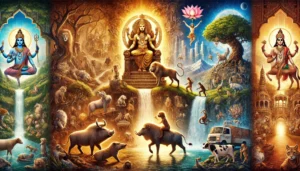
Reincarnation and animals in Hinduism
FAQs on “Reincarnation and Animals: Exploring the Soul’s Journey Through the Cycle of Samsara”
- What is reincarnation, and how does it relate to animals?
Reincarnation, or samsara, is the process where the soul undergoes a continuous cycle of birth, death, and rebirth. Animals play a significant role in this cycle as potential forms for the soul to inhabit, based on its accumulated karma. Each form, including animals, offers a unique experience to the soul on its journey toward enlightenment.
- How is karma connected to being reborn as an animal?
Karma refers to the actions, thoughts, and intentions of a being, which shape the circumstances of future births. Negative actions dominated by greed, violence, or ignorance may lead to rebirth in lower life forms, such as animals. Conversely, good karma elevates the soul toward human or even divine incarnations.
- Why are animals considered part of the spiritual journey in Hinduism?
Animals are viewed as integral to the soul’s journey because they embody a simpler state of existence where the mind is less burdened by ego and desires. This state allows the soul to experience different aspects of creation, contributing to its evolution and preparation for higher forms of life.
- What does Hindu mythology say about reincarnation in animal forms?
Hindu mythology is rich with stories of reincarnation involving animals. For instance:
Vishnu’s Dashavatar showcases divine incarnations as a fish (Matsya), turtle (Kurma), boar (Varaha), and lion (Narasimha).
King Bharata, due to his attachment to a deer, was reborn as a deer in his next life.
These stories emphasize the fluid nature of reincarnation and the significance of animals in the cosmic order.
- Can humans be reborn as animals, and why?
Yes, humans can be reborn as animals if their actions or mental state are dominated by primal instincts or harmful deeds. For example, excessive greed or cruelty might result in a birth as an animal to work through such tendencies. It is believed this serves as a form of spiritual correction.
- What qualities or karmic debts might lead to specific animal reincarnations?
Different animals are believed to represent specific karmic traits or debts. For instance:
A soul reborn as a lion may reflect past dominance or aggression.
A snake reincarnation could symbolize transformation or unresolved fears.
A cow may represent purity and service due to its sacred status in Hinduism.
Each form provides opportunities to balance karma and grow spiritually.
- How do Vedic scriptures view the evolution of the soul through animal forms?
Vedic texts outline that the soul evolves through 8.4 million life forms, starting from microorganisms to plants, animals, and finally, humans. This evolutionary cycle allows the soul to develop higher consciousness, with human life considered the pinnacle for achieving moksha (liberation).
- Can souls achieve liberation (moksha) while in animal forms?
While it is rare, souls in animal forms can attain liberation if they receive divine grace or have accumulated sufficient good karma from past lives. Such instances are seen as extraordinary and often tied to spiritual intervention, as animals generally lack the conscious ability to perform intentional spiritual practices.
- Are there stories of animals attaining spiritual liberation in Hinduism?
Yes, several stories illustrate animals achieving spiritual liberation:
In the Ramayana, Jatayu, a vulture, sacrifices his life protecting Sita and is liberated by Lord Rama.
In the Mahabharata, the dog accompanying the Pandavas to the gates of heaven is revealed to be Dharma in disguise, signifying the spiritual worthiness of animals.
- What is the significance of animals in divine incarnations?
Animals play a prominent role in divine manifestations in Hinduism. The animal avatars of Vishnu, such as Matsya (fish) and Narasimha (lion-man), emphasize the importance of all life forms in maintaining cosmic balance. They also highlight the interconnectedness between humans and animals in the spiritual realm.
- How do beliefs in reincarnation affect the treatment of animals in Hindu culture?
The belief in reincarnation fosters respect and compassion toward animals, as they are seen as fellow travelers in the spiritual journey. This perspective has led to the principles of ahimsa (nonviolence) and vegetarianism, both deeply rooted in Hindu philosophy.
- How does reincarnation influence vegetarianism in Hinduism?
Hindus often adopt vegetarianism as an ethical choice to minimize harm to other sentient beings, recognizing that animals possess souls undergoing their own spiritual journeys. Consuming animal flesh is seen as interfering with this process and creating negative karma for oneself.
- What role do animals play in temple rituals and offerings?
While animal sacrifices were part of ancient Vedic rituals, many modern Hindu traditions have replaced such practices with symbolic offerings like coconuts and fruits. Certain animals, like cows, are considered sacred and are revered in temple settings as embodiments of purity and divine grace.
- How do other religions view reincarnation and animals?
Buddhism: Shares the belief in reincarnation, where animals are part of the karmic cycle.
Jainism: Strongly emphasizes nonviolence and protection of all life forms due to their belief in reincarnation.
Western Traditions: Some indigenous and mystical traditions also believe in the soul’s journey through animals as part of the spiritual cycle.
- What spiritual lessons can humans learn from animal reincarnation?
Beliefs in animal reincarnation teach humans empathy, interconnectedness, and humility. They remind us that all living beings are manifestations of the divine and deserve respect and kindness.
- Do modern scientists or philosophers explore reincarnation and animals?
Yes, modern studies on reincarnation, such as those by Dr. Ian Stevenson, explore anecdotal evidence of past-life memories, some of which include claims of animal forms. Philosophers and ecologists also discuss the spiritual connection between humans and animals in the broader context of life cycles.
- How do reincarnation beliefs influence wildlife conservation?
The spiritual view of animals as part of the reincarnation cycle has inspired conservation efforts. For instance, many Hindu temples act as sanctuaries for animals like monkeys, cows, and elephants, emphasizing their sacred role in the ecosystem.
- Are there meditative practices to understand past lives, including animal reincarnations?
Certain spiritual traditions, like yoga and meditation, offer techniques to explore past-life memories. However, these practices require guidance from experienced teachers and are not solely focused on animal forms but the soul’s overall journey.
- Can reincarnation explain the bond between humans and animals?
Many believe that strong bonds with animals, such as pets, could be due to past-life connections. This view deepens the emotional and spiritual relationship between humans and their animal companions.
- How can we honor the concept of reincarnation in our relationship with animals?
To honor the belief in reincarnation:
Practice kindness and compassion toward animals.
Adopt sustainable and ethical lifestyles that minimize harm to other beings.
Support animal welfare and conservation initiatives.
Reflect on the interconnectedness of life and how every soul contributes to the greater spiritual journey.
Summary
The article delves into the profound concept of reincarnation in Hindu philosophy, emphasizing the soul’s journey through various life forms, including animals, as part of the cycle of samsara (birth, death, and rebirth). It explores scriptural references, such as the Bhagavad Gita and Upanishads, which highlight the interconnectedness of all living beings and the spiritual significance of animal lives in shaping karma and spiritual evolution. The article also examines cultural beliefs, rituals, and stories that illustrate the soul’s transition through animal forms, emphasizing the ethical responsibility toward animals and their spiritual role in human life.
Related Articles
- The Tridevi: Lakshmi, Saraswati, and Parvati – Their Roles and Powers
- “Divine Creatures of Ancient Indian Scriptures: Exploring the Role of Animals in the Vedas, Puranas, and Mahabharata”
- Nature and Spirituality: Exploring the Sacred Essence of the Himalayas, Ganga, and Other Natural Wonders”
- “Reviving the Gurukul System: Relevance and Lessons for Modern Education”
- “Exploring Greek and Indian Mythology: Similarities Between Greek and Indian Mythology “
- “Embracing Sattvic Living: Harmonizing Mind, Body, and Soul Through Food and Lifestyle”
- “Charity and Prosperity: Exploring the Concept of Daan and Its Financial Relevance in Modern Life”
- How to Build an Eco-Friendly Home Inspired by Vastu Shastra
- Comparison of Ancient and Modern Sports: How Traditional Sports Have Influenced Contemporary Games
- “Timeless Lessons from Ancient Tales: Linking Samudra Manthan and Ganga’s Descent to Modern Ecological Challenges”
- “Reviving Sanskrit: How AI is Preserving Ancient Languages for the Future”
- “Mathura: The Sacred Land of Lord Krishna’s Divine Leelas”
- Investing for Future Generations: Lessons from Indian Traditions on Legacy Building and Wealth Preservation
- “Ancient Indian Wisdom: Timeless Lessons for Tackling Today’s Climate Crisis”
- “Artificial Intelligence and Spirituality: Transforming Ancient Practices for the Modern World”
- “Gold and Real Estate in India: Timeless Assets Shaping Financial Strategies”
- “Divine Feminine Power in Hindu Mythology: The Legends of Durga, Saraswati, and Lakshmi”
- “Divine Beings of Sanatan Dharma: The Spiritual Significance of Sacred Animals in Hinduism”
- “Symbolism in Mythological Art: Unlocking Hidden Meanings in Ancient Temple Carvings”
- “Exploring Technological Advancements in Ancient India and Civilizations: Vimana, Metallurgy, & Water Management systems”
- Unveiling the Mysteries: Ancient Temples of Sanatan Dharma , Mysterious Temples of India
- “The Scientific Knowledge of Sanatan Dharma: Ancient Wisdom Meets Modern Science”
- Ancient Indian Sports and Games: Celebrating a Legacy of Skill, Strength & Strategy”
- “Exploring the Cosmic Link: The Connection Between Astronomy and Vedic Astrology”
- The Power of Sanskrit: Unlocking the Divine Language of the Gods
- “The End of Kaliyuga: A Sanatan Insight into the World’s Final Chapter”
- Explore more articles on Prachin Sanatan Yuga.
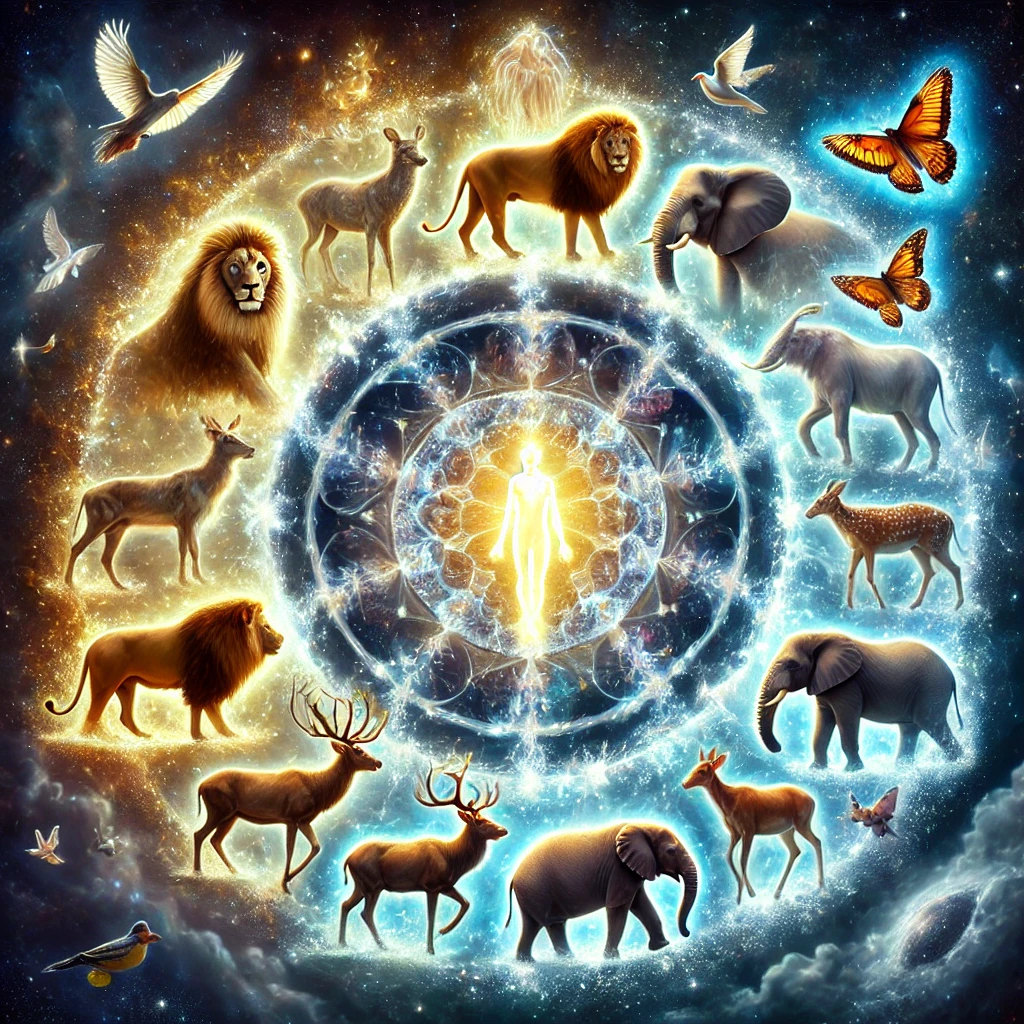
Thanks for the information, keep it up
Thanks❤